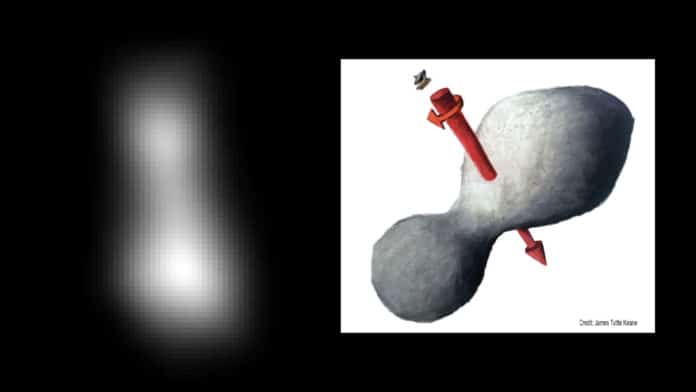New Horizons made history with the flyby of Ultima Thule, a mysterious object 4.1 billion miles (6.6 billion kilometers) from Earth in the Kuiper Belt. It’s the farthest flyby of an object in our solar system.
The spacecraft flew past Ultima Thule in the early hours of New Year’s Day, introducing the era of exploration from the confounding Kuiper Belt, a region of primordial objects that hold keys to understanding the starting points of the solar system.
NASA Administrator Jim Bridenstine said, “Congratulations to NASA’s New Horizons team, Johns Hopkins Applied Physics Laboratory and the Southwest Research Institute for making history yet again. In addition to being the first to explore Pluto, today New Horizons flew by the most distant object ever visited by a spacecraft and became the first to directly explore an object that holds remnants from the birth of our solar system.”
Pictures taken amid the shuttle’s approach— which brought New Horizons to inside only 2,200 miles (3,500 kilometers) of Ultima at 12:33 a.m. EST — uncovered that the Kuiper Belt object may have a shape like a rocking the bowling alley stick, spinning end over end, with measurements of roughly 20 by 10 miles (32 by 16 kilometers).

Credits: NASA/JHUAPL/SwRI
Another probability is Ultima could be two objects orbiting one another. Flyby information has officially understood one of Ultima’s secrets, demonstrating that the Kuiper Belt object is spinning like a propeller with the hub indicating roughly New Horizons. This clarifies why, in prior pictures taken before Ultima was settled, its brightness didn’t seem to fluctuate as it rotated. The group has still not decided the rotation period.
Principal Investigator Alan Stern, of the Southwest Research Institute in Boulder, Colorado said, “New Horizons performed as planned today, conducting the farthest exploration of any world in history — 4 billion miles from the Sun. The data we have look fantastic and we’re already learning about Ultima from up close. From here out the data will just get better and better!”
Johns Hopkins Applied Physics Laboratory Director Ralph Semmel said, “New Horizons holds a dear place in our hearts as an intrepid and persistent little explorer, as well as a great photographer. This flyby marks a first for all of us — APL, NASA, the nation and the world — and it is a great credit to the bold team of scientists and engineers who brought us to this point.”
Adam L. Hamilton, president and CEO of the Southwest Research Institute in San Antonio said, “Reaching Ultima Thule from 4 billion miles away is an incredible achievement. This is exploration at its finest. Kudos to the science team and mission partners for starting the textbooks on Pluto and the Kuiper Belt. We’re looking forward to seeing the next chapter.”
The New Horizons spacecraft will continue downloading images and other data in the days and months ahead, completing the return of all science data over the next 20 months.
Almost 13 years after the launch, the spacecraft will continue its exploration of the Kuiper Belt until at least 2021. Team members plan to propose more Kuiper Belt exploration.
